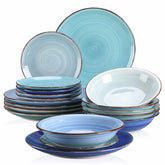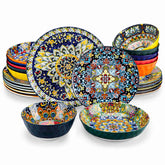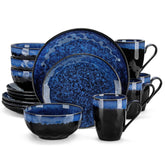Baking Pans vs. Baking Dishes: Your Ultimate Guide to Choosing the Right Bakeware
Baking is a beautiful blend of creativity and chemistry, and every aspect, from ingredients to temperature, is crucial. However, one of the most overlooked factors that affect your results greatly is the bakeware you use. Most home bakers are likely to confuse baking pans with baking dishes, thinking that they are interchangeable. Although they both go in the oven and hold food, they are very different in terms of material, function, and results. The wrong one may lead to overcooked edges, undercooked centers, or broken dishes.
This guide goes deep into the differences between baking pans and baking dishes, and will help you make the right choice depending on your recipe and desired outcome.
What is a Baking Pan?
A baking pan is usually a shallow metal container, for example, aluminum or stainless steel, which is capable of conducting heat rapidly and evenly. Baking pans are commonly used for recipes that need to be cooked quickly or have crisp edges, such as cakes, brownies, cookies, and roasted vegetables. The rapid heat transfer enables a crusty exterior and a soft or firm interior, depending on the recipe. There are many types of baking pans, such as sheet pans for cookies, round and square cake pans, muffin tins, loaf pans, and Bundt pans. Each type is designed for a particular baking need and guarantees that the texture and structure of the food are perfect.
What is a Baking Dish?
Baking dishes are usually deeper than baking pans and are made of glass, ceramic or stoneware. These materials are slow to conduct heat and distribute it evenly, making them perfect for dishes that need to be cooked for a long time and with gentle heat, such as casseroles, baked pasta, custards, and bread puddings.
The primary purpose of a baking dish is to contain moist or layered recipes that require a gentler baking process. Popular materials for baking dishes are glass, which enables you to see the food as it cooks. Ceramic is good at retaining heat and looks nice for serving, but stoneware is better at retaining heat and has a rustic look. These dishes are typically of standard shapes such as rectangular, square or oval and are often made to be oven-to-table, which makes them functional and decorative.
When is a Baking Dish Used?
When your recipe requires a lot of moisture, layers, or slow baking, you should reach for a baking dish. Imagine dishes such as lasagna, baked ziti, chicken pot pie, cobblers, or scalloped potatoes. These recipes are enhanced by the uniform heat that ceramic or glass offers.
Baking dishes are ideal for dishes that require time for the flavors to blend or for textures to change gradually, such as cooking raw pasta or turning custard into a smooth dessert. They are also easy to use for one-dish meals because they stay warm for a longer time after being removed from the oven and can be served straight to the table, saving time and cleaning up.
Baking Pan vs. Baking Dish: The Critical Differences
Although both baking pans and dishes can be used to cook in the oven, they are constructed differently and react differently to heat. Baking pans, which are made of metal, are shallow and heat up fast. This makes them perfect for items that need to rise, set or brown quickly. They are great for cookies, sheet cakes, and roasted vegetables. Baking dishes, on the other hand, are deeper and are made of ceramic or glass, which heat slowly but retain warmth.
This makes them ideal for foods that need slow cooking, like casseroles and gratins. The depth also implies more space for layers and liquids. In addition, although pans are not typically used for serving, dishes are often designed with aesthetics in mind, which makes them a smooth transition from oven to table. Knowing these differences will help avoid typical baking mistakes like soggy brownies in a glass dish or burnt edges on a casserole in a metal pan.
Why the Difference Matters: Achieving Baking Success
Incorrect bakeware can ruin the outcome of your dish. Material is one of the greatest factors. Metal conducts heat quickly and reacts quickly to temperature changes, which is perfect for crisp edges and evenly baked goods. That’s why brownies or cookies are best baked in metal pans – they require that quick heat to set. On the contrary, ceramic and glass distribute heat more slowly and evenly, which prevents the center of layered or wet dishes from burning before the inside is cooked. The depth and shape of your bakeware also contribute. Shallow pans encourage browning and steam escape, which leads to crisp textures.
Dishes that are deeper hold moisture and are more appropriate for saucy or custard recipes. Even the corners count – metal pans with sharp corners give clean edges on brownies, while rounder ceramic dishes give a softer, more rustic finish. The kind of bakeware you use influences everything from texture to cooking time and even presentation.
Choosing Your Bakeware
One of the best ways to determine which bakeware to use is to look directly at your recipe. If you are baking brownies, a metal pan is perfect because it produces firm edges and a chewy texture. Cakes also enjoy metal pans for structure and rise.
For lasagna or baked mac and cheese, use a ceramic or glass dish to make sure the inside is cooked through without drying out. Roasted vegetables are happy with the high heat and surface area of a metal sheet pan, while a cobbler or bread pudding will bake more evenly in a ceramic or glass dish.
If your recipe requires even heat and moisture retention, choose a dish. If it needs precision, rise, and crispiness, a pan is the way to go. Imagine the bakeware as an extension of your recipe—it’s not just a vessel, but a utensil that influences every bite.
How to Handle and Maintain Your Bakeware
Proper care of your bakeware will extend its life and make your food taste good. For metal pans, line them with parchment paper when baking sticky items like brownies or cookies to prevent sticking and clean up. Do not cut directly in the pan, particularly if it is nonstick, to prevent damage. Wash by hand if possible to preserve the surface and avoid warping.
For glass and ceramic dishes, avoid thermal shock – never place a hot dish on a cold surface or vice versa. Let the dish cool down a bit before washing, and do not move it from the freezer to the oven or from the oven to the fridge. These materials can crack or shatter when there is a sudden change in temperature. Use non-abrasive sponges to prevent scratching the finish, and do not stack heavy items on top in storage.
Always grease or butter the surface when the recipe requires it, especially with baked goods, to ensure easy release. By adhering to these simple guidelines, your bakeware will last for years and continue to provide you with great results.
Choosing the right bakeware might seem like a small detail, but it is an important factor in your baking success. Baking pans and baking dishes are not interchangeable, they have different functions and create different textures, cooking time and appearance. Metal pans are best for crisp, structured items like cakes, cookies, and roasted veggies, while ceramic or glass dishes are best for moist, layered, or custard-filled recipes.
Understanding how each material reacts in the oven will help you make wise decisions and prevent common baking mistakes. Whether you are preparing a classic lasagna, a batch of fudgy brownies, or a fruit cobbler, let your recipe dictate your choice. With the right bakeware in your hands, every dish you prepare will be better, more consistent, and more enjoyable to share.













